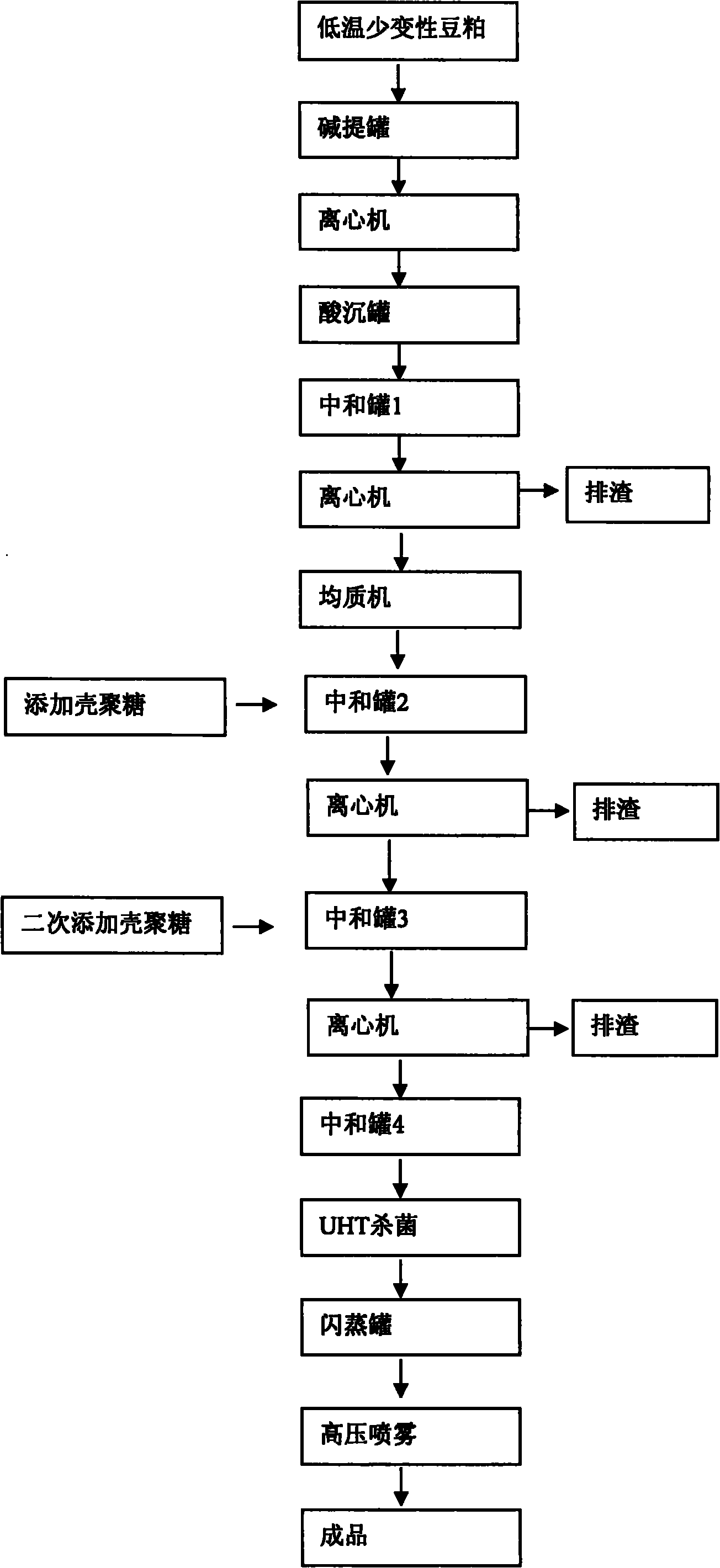Process method for removing residual arsenic, lead and copper in soy protein isolate
A technology of soybean protein isolate and process method, which is applied to the protein composition of vegetable seeds, protein food components, food science, etc., to achieve the effect of improving food safety
- Summary
- Abstract
- Description
- Claims
- Application Information
AI Technical Summary
Problems solved by technology
Method used
Image
Examples
Embodiment 1
[0024] 1. Adsorbent: Dissolve 10 g of chitosan with a deacylation degree of 95% in 1000 mL of 1% (v / v) acetic acid solution to prepare a 1% (w / v) chitosan solution.
[0025] 2. Process
[0026] (1) Alkaline extraction, first carry out alkaline extraction twice with low temperature and low denaturation soybean meal with sodium hydroxide. Alkaline extraction for the first time: Add water to the low-temperature and low-denatured soybean meal at a ratio of 1:10 by weight of material to liquid, mix well and use sodium hydroxide with a concentration of 20% (w / w) at a temperature of 50°C and a stirring rate of Under the condition of 60rpm, carry out alkaline extraction for 30min, and adjust the pH value of the solution to 7.0, then use a centrifuge for centrifugation at 3500-4500rpm, and add water to the filter residue according to the ratio of material to liquid weight ratio of 1:5, and then add a concentration of 20 % (w / w) of sodium hydroxide at a temperature of 50°C and a stirri...
Embodiment 2
[0035] One, adsorbent, with embodiment 1.
[0036] 2. Process
[0037] (1) Alkaline extraction, take low-temperature low-denatured soybean meal as raw material to carry out two alkali extractions, the ratio of liquid to liquid for the first alkali extraction is 1:8, the temperature is 45°C, the stirring speed is 60rpm, the alkali extraction is 50min, and when the pH value of the solution is 7.5, centrifuge Separation; the solid-liquid ratio of the second secondary alkali extraction is 1: 6, the temperature is 40° C., the stirring rate is 60 rpm, the alkali extraction is 30 min, and when the pH value of the solution is 7.5, after centrifugation, the two extracts are combined for subsequent use, and the others are the same as above.
[0038] (2) Acid precipitation, in the extract of (1), stirring speed 40rpm, add the hydrochloric acid that concentration is 0.01mol / L to adjust pH value to be 4.4, centrifuge, obtain protein precipitate for subsequent use, others are the same as ab...
Embodiment 3
[0047] One, adsorbent, with embodiment 1.
[0048] 2. Process
[0049] (1) Alkali extraction, take the raw material low-temperature and low-denaturation soybean meal for secondary alkali extraction. The solid-liquid ratio of the first alkaline extraction is 1:12, the alkaline extraction temperature is 50° C., the stirring rate is 80 rpm, and the alkaline extraction is 40 minutes. When the pH value of the solution is 7.5, centrifuge; the ratio of liquid to liquid for the second alkali extraction is 1:6, the temperature of alkali extraction is 50°C, the stirring rate is 80rpm, the alkali extraction is 10min, and when the pH value of the solution is 7.5, after centrifugal separation, two extractions The liquid is combined and set aside.
[0050] (2) acid precipitation, in the extract of (1), under stirring rate 40rpm, adding concentration is that 0.01mol / L hydrochloric acid adjusts pH value to be 4.6, centrifugal separation, obtains protein precipitate for subsequent use, other...
PUM
 Login to View More
Login to View More Abstract
Description
Claims
Application Information
 Login to View More
Login to View More - R&D
- Intellectual Property
- Life Sciences
- Materials
- Tech Scout
- Unparalleled Data Quality
- Higher Quality Content
- 60% Fewer Hallucinations
Browse by: Latest US Patents, China's latest patents, Technical Efficacy Thesaurus, Application Domain, Technology Topic, Popular Technical Reports.
© 2025 PatSnap. All rights reserved.Legal|Privacy policy|Modern Slavery Act Transparency Statement|Sitemap|About US| Contact US: help@patsnap.com



